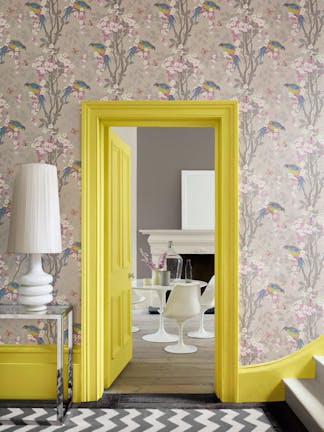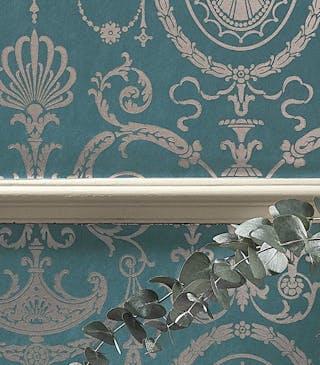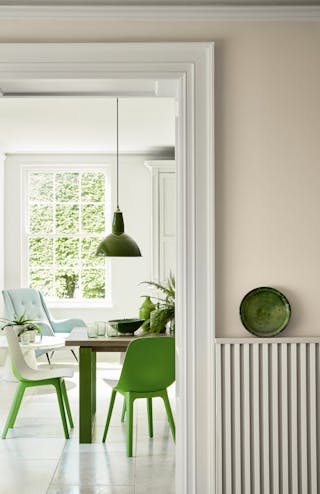Refreshing woodwork within a space is a simple and effective way of updating an existing scheme. Often, skirting boards are painted a neutral or white shade out of habit. However, their proportion makes skirting boards the perfect opportunity to add a little colour.
How to incorporate skirting boards into your scheme
All-Over: Paint Walls and Skirting Boards in the Same Tones
Paint walls and skirting boards in the same shade for an all-over wrap-around scheme that feels comforting and enveloping. This works particularly well with warm, jewel-tones or muted greens to evoke serenity and the calm of the outdoors.
Coordinated Colours: Select a Deeper Shade for Woodwork
Combine colours from the same Colour Scales families for a harmonious finish. Use a deeper strength of the same pigment on woodwork, alongside a lighter shade on walls for a gentle contrast. For example, use Dorchester Pink – Deep on woodwork with Dorchester Pink on the walls.
Colour Highlight: Use Bold, Bright Tones on Skirting Boards
If your space features patterned wallpaper, consider pulling out a bold, bright shade from the design for your skirting boards. This approach will help to draw all elements of the scheme together. Here, ‘Loriini - Dorian’ is paired with the accent colour ‘Trumpet’, for a stand-out, contemporary look.
Colour Block: Use Colour Blocking For A Focal Point
Elongate skirting boards by using the same colour on woodwork and the lower half of the wall. This type of colour blocking creates contrast and adds a focal point in place of architectural features.
Neutral: Opt For Neutral Skirting Boards
For a timeless finish, use an off-white or clean white. Choose a shade of white that complements your chosen wall colour and enhances skirting and door frames. If white feels a little bright, consider a neutral like ‘French Grey Pale’ or ‘Slaked Lime’ for a softer contrast.
Choosing a paint finish for skirting boards
Selecting the right type of paint for your interior decoration projects is crucial for ensuring a beautiful result. We recommend the following finishes for skirting boards.

Intelligent Satinwood
Intelligent Satinwood is a durable, water-based paint that’s ideal for interior woodwork. Our satin sheen finish is specially formulated to withstand the many knocks delivered to wooden furniture and surfaces in the home.
Satinwood offers the durability of a traditional paint, but with a sophisticated low sheen level of 30-35%.
Discover our full palette of colours in Intelligent Satinwood
Intelligent Eggshell
Formulated to resist moisture, staining and general wear and tear, Intelligent Eggshell is ideal for kickboards around the home. Our intelligent range of eggshell paints are tough, fully-washable finish.
Choose Intelligent Eggshell if you’d prefer a low-sheen level in your chosen colour.
Explore our range of colours available in Intelligent Eggshell
Intelligent Gloss
For sophisticated gloss skirting boards that are tough, washable, and distinctive, choose our Intelligent Gloss finish. Choose Intelligent Gloss for skirting boards in rooms that need regular cleaning. This finish is ideal for kitchens and bathrooms in particular.
For more information, explore our Intelligent GlossHow to Paint Skirting Boards: Step by Step
We would recommend following the below steps for ensuring the best result when painting your skirting boards. The same instructructions also apply for painting architrave, interior doors, panelling, and architectural features such as dado rails and picture rails.
How to prepare skirting boards for painting
- Ensure you clean the skirting boards before painting because woodwork tends to attract more dirt than walls. Use a small amount of detergent and wet ‘n’ dry abrasive paper to clean and sand the surface at the same time.
- Protect the floor with newspaper or cardboard, using masking tape to secure it at the edges. Whether you’re painting skirting boards with carpet or hard floors alongside, a secure protective layer is vital.
- Remove any old flaking paint. Fill any surface abrasions and sand them to a smooth finish. The paint will provide a beautiful finish but it isn’t capable of concealing cracks and holes.
- Sand any previously painted woodwork that’s still in good condition to provide a key. Sanding is particularly important for glossy finishes. If the surface is consistent, no other undercoats should be required. Otherwise apply one coat of Little Greene Intelligent ASP (All Surface Primer).
How to apply paint to skirting boards
- Use a small brush to apply paint at the extremities of the surface and into any intricate mouldings. Take care not to let the paint pool in crevices where it will slowly sag or drip while it dries.
- Cover larger areas efficiently with a small foam roller or bigger brush, depending on scale. A popular way of painting woodwork is to use a roller to efficiently apply the paint, and a brush to ‘lay-off’ the surface while the paint is still wet. This avoids the orange-peel effect associated with overly-hasty paint application, or too long a nap (of the roller).
Explore our wood paint finishes in more detail before choosing the best paint for your project.
Browse our image gallery for more room and colour inspiration.
















